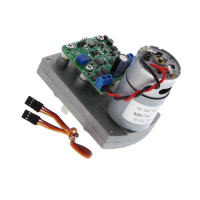The servo motor - a little all-rounder
If you are active in model building, then you have certainly come across servo motors. Servo motors, colloquially also called servo, are mainly used in RC model building. There is a good reason for this: both the angular position and the rotational speed of servo motors can be precisely determined. Servos thus offer a decisive advantage over other motors.
In RC model building, the motors are often used to control aircraft wings or to control axes. Servo motors are also characterized by their comparatively small size. They are therefore ideal for installation in small, closed systems.
Different servos for your project
Probably the most important point of differentiation for servo motors is the angle of rotation of the motors. We distinguish between 90°, 180°, 270° and 360° servos. This angle of rotation is always given as a maximum value. A 90° servo can therefore approach all angles of rotation up to and including 90°, a 270° servo all angles up to 270°.
This is achieved in microelectronics with the so-called pulse width modulation (PWM). The PWM pin (marked by a wave ~ on Arduino compatible microcontrollers) only receives a signal for a certain pulse duration. The length of the pulse duration determines the achieved angle of rotation of the wave.


